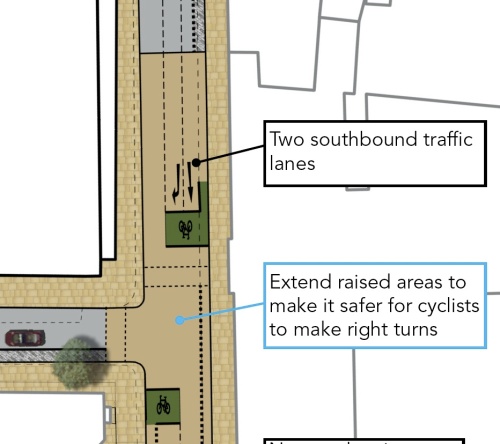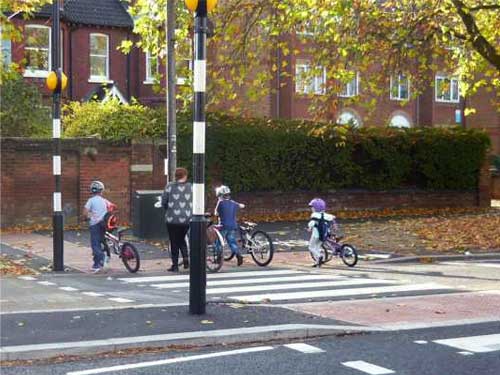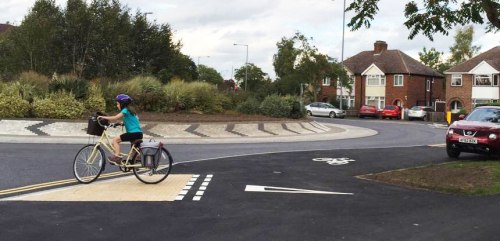Most people don’t like cycling amongst motor vehicles. It’s a simple concept which many somehow fail to understand.
A popular cycleway has been removed, so now people cycling are expected to use the carriageway. The people who cycle there are upset.
But the local cycle campaign think it’s great that everyone, from children to the elderly, must now cycle amongst cars, vans and buses.
Sounds familiar – could be Britain, right? Well, it’s actually happening in Hamburg.
You can watch a short video about it, from German TV, and below you’ll find a transcript which I’ve translated into English, with help from Katja Leyendecker at the tricky bits.
VOICE-OVER:
Cycling along the Alster [a lake] in Hamburg.
For some, a stress-free route to work. For others, simply relaxation. This, in the middle of the city.
Every day 4,300 people cycle along this stretch. But the joy of cycling here is now over for many. A long section of the old cycleway has simply been removed. Completely without reason, many feel.
MAN IN BLUE JACKET:
It was a wonderful cycleway along the Alster, where one could be really relaxed while cycling.
WOMAN WITH BEIGE HAT:
It’s a real shame, because it was separated, not squeezed together with people walking, it was really well protected and worked so well.
MAN WITH SILVER CYCLE HELMET:
It was an absolutely wonderful, great cycleway. And it is no more.
WOMAN WITH BLUE SCARF:
Cycling along here you could look out at the lake… and now we have to look at cars. What a pity.
VOICE-OVER:
Here, the Hamburg traffic department have planned something different. They want the road next to the existing cycleway to become a so-called “cycle-street” on which people cycling share with motor vehicles.
But it’s not entirely finished – and the cycleway has already been ripped up anyway.
MAN IN BLACK HOOD:
Completely stupid. It’s no fun riding on the road every day.

A view of riding along the cycle-street, between parked cars and oncoming motor traffic.
MAN IN BLACK CYCLE HELMET:
It’s unacceptable, because cyclists now have to go elsewhere. And nobody wants to cycle on the road. I already saw a cyclist lying under a car.
WOMAN WITH FURRY HOOD:
I cycle that route a lot, and yesterday I was verbally abused, because I was cycling on the road.
WOMAN WITH BLACK HAT:
It’s impossible, you have to overtake parked cars, kids are expected to cycle here, on their way to/from school, people open car doors quickly, it’s impossible.

The so-called “cycle street” which could easily be mistaken for any motor-dominated road
VOICE-OVER:
And so, this is how it looks further north, where it’s already a cycle-street: “20’s plenty” for everyone, people may cycle side-by-side, a peaceful mixing of car and bicycle.
Well, that’s the idea.
Some even think it’s good.
ERWIN SÜSELBECK, ADFC HAMBURG (local branch of national cycling organisation):
This street is optimally suitable for a cycle-street. It has little motor traffic, very little motor traffic, it has enough width. The cycleway was always too narrow, there was always conflict with people walking, and it works here, as anyone can see, cyclists are traveling amongst the drivers, it all works. On the road one can safely and comfortably travel, therefore it makes sense to put the cycle traffic there.
[Note that as he says this, behind him you can see someone choosing to ride on the footway rather than mix with motor vehicles on the “optimally suitable” road.]

A person cycling in the background votes with their feet, choosing the footway instead of the motor-dominated cycle street, making Erwin Süselbeck look somewhat silly.
VOICE-OVER:
But while we were filming, several passing cyclists felt the need to stop and voice their concerns.
MAN IN GREY COAT:
Just this week, I’ve had three situations that were very close. You are lobbying for cycling, right? It’s a busy street, it’s no good for cycling.
ERWIN SÜSELBECK, ADFC HAMBURG:
That’s not correct, this road is optimally suitable for a cycle-street.
MAN IN GREY COAT:
When the drivers overtake at 30 miles per hour?
ERWIN SÜSELBECK, ADFC HAMBURG:
No, they shouldn’t drive that fast.
MAN IN GREY COAT:
But they do it anyway!
VOICE-OVER:
The city of Hamburg has spent around 20,000 Euros to rip out the old cycleway. But the cycle-street won’t be ready until at least 2017. So cyclists just have to use the road as it is.
Just what was the transport department thinking?
SUSANNE MEINECKE, HAMBURG TRANSPORT AUTHORITY:
We’re not forcing anybody. Cyclists are safe on the road here. And we want to offer something reasonable for cyclists, and the old cycleway wasn’t a reasonable offering.
VOICE OFF-CAMERA:
But you are forcing people, you’ve ripped out the cycleway already.
SUSANNE MEINECKE, HAMBURG TRANSPORT AUTHORITY:
Yes, but with that, we’re giving them a cycle-street.
VOICE OFF-CAMERA:
That nobody wants.
SUSANNE MEINECKE, HAMBURG TRANSPORT AUTHORITY:
[Long pause…] I honestly don’t understand your questions. There are very few people driving here, and cyclists are safe on the road. I don’t understand the problem.
VOICE-OVER:
Many citizens clearly see it differently.
MAN IN BROWN COAT:
You don’t travel here.
SUSANNE MEINECKE, HAMBURG TRANSPORT AUTHORITY:
How would you know?
MAN IN BROWN COAT:
Most people who cycle here laugh at your plans.
SUSANNE MEINECKE, HAMBURG TRANSPORT AUTHORITY:
That’s not true.
MAN IN BROWN COAT:
The people who do are in danger. Just look at the traffic. This type of vehicle [points at tourist bus] I’ve been endangered a few times myself. Look at this, they’re deadly dangerous. They travel along here one every minute, and they don’t care that it’s a cycle-street, or about the 20mph limit, or any such things. It’s deadly dangerous here.

“Look at this, they’re deadly dangerous.”
VOICE-OVER:
Many feel that instead of the controversial cycle-streets, they would prefer new cycleways to be built. Many roads in the city have none, and some of those that do exist are so bad that they barely deserve to be called cycleways.
MAN IN SILVER CYCLE HELMET:
I think it’s senseless planning. When there are so many potholes in Hamburg, frost damage, but there’s money for pointless stuff.
WOMAN IN BEIGE HAT:
I can’t believe that they’ve frittered away so much money – our money – on complete nonsense.
VOICE-OVER:
Even though the transport authorities may have meant well, for many cyclists this project has caused more problems than it has solved.
It makes me angry that some cycle campaigners continue to ignore the general public who repeatedly say time and time again that they don’t want to cycle amongst motor traffic.
Frau Meinecke may not understand the problem, but I can explain it to her easily: This debacle demonstrates the dangers of listening only to confident cyclists and ignoring the everyday users of cycling for transport.


















 The Alternative Department for Transport is written by, and the personal opinion of,
The Alternative Department for Transport is written by, and the personal opinion of, 


